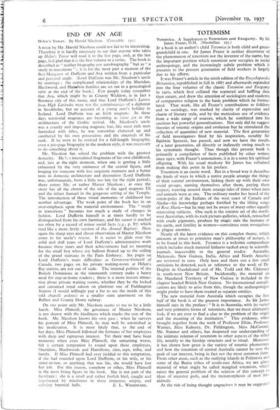END OF AN AGE
Helen's Tosser. By Harold Nicolson. (Constable. 15s.)
A Boox by Mr. Harold Nicolson could not fail to be interesting. Therefore it is hardly necessary to say that anyone who takes up Helen's Tower will read it to the last page, and, at the last page, feel glad that it is the first volume in a series. The book is described as " neither biography nor autobiography " but as " a study in transitions " ; it is for the most part a memoir of the first Marquess of Dufferin and Ava written from a particular and personal angle. (Lord Dufferin was Mr. Nicolson's uncle by marriage ; the complicated relationships of the Sheridan, Blackwood, and Hamilton families are set out in a genealogical table at the end of the book.) Few people today remember that Ava, which might be in County Wicklow, is in fact a Burmese city of this name, and that Lord Dufferin's Letters from High Latitudes were not the reminiscences of a diplomat in Stockholm, but an account of a young man's holiday in Iceland. Lord Dufferin was an Irish magnate. In these days territorial magnates are becoming as vieux jeu as the architecture of the Gothic revival. Mr. Nicolson's uncle was a courtly and imposing magnate, but, like most rich men furnished with titles, he was somewhat cluttered up and cumbered by his own possessions and the externals of his rank. If he were to be revived for a full-length biography, even a 300-page biography in the modern style, it was necessary to do something about it.
Mr. Nicolson has solved the problem with the greatest dexterity. He 1-..7s intercalated fragments of his own childhood, and, just at the right moment, when one is getting a little exhausted by the very eminence of the central figure, and longing for someone with less exquisite manners and a better taste in domestic architecture and decoration (Lord Dufferin was, unfortunately, born a little too late for the right period), there enters Mr. or rather Master Nicolson ; at once the story has all the charm of the tale of the aged magnate Eli and the infant Samuel in the gorgeous setting of the Temple. The introduction of these visual memories of childhood has another advantage. The weak point of the book lies in an over-emphasis upon the material environment. The " study in transitions " becomes too much a study of changes in fashion. Lord Dufferin himself is at times hardly to be distinguished from his own furniture, and his career is marked too often by a record of minor social facts (e.g., p. 87) which read like a more lively version of the Annual Register. Here again the sharp eyes and clever observation of Master Nicolson come to his uncle's rescue. It is easier to glide over the solid and dull years of Lord Dufferin's administrative work because these years and their achievements had no meaning for the small boy whose toy balloon floated up to the ceiling of the grand staircase in the Paris Embassy. Six pages on Lord Dufferin's main difficulties as Governor-General of Canada, two pages on his private waiting-room at Helen's Bay station, are not out of scale. The internal politics of the British Dominions in the nineteenth century make a heavy meal for stay-at-home readers ; there is a more instant attrac- tion about private waiting rooms, whether they be the locked and curtained royal saloon on platform one of Paddington Station (I would willingly pay a fee to see the inside of this odd chapelle ardente) or a smaller state apartment on the Belfast and County Down railway.
On one point only Mr. Nicolson seems to me to be a little harsh. Miss Plimsoll, the governess of Master Nicolson, is not drawn with the kindliness which marks the rest of the book. Mr. Nicolson knows his own past ; when he surveys his portrait of Miss Plimsoll, he may well be astonished at his moderation. It is most likely that, to the end of her days, Miss Plimsoll followed the fortunes of her employers with deep and rapturous interest. Yet there may have been moments when even Miss Plimsoll, the unturning worm, felt a certain temptation to round upon these employers, Sheridans, Blackwoods and Hamiltons, clan, sept, tribe, and family. If Miss Plimsoll had ever yielded to this temptation, if she had rounded upon Lord Dufferin, or his wife, or his sister-in-law, or anything that was his, she would have lost her job. For this reason, somehow or other, Miss Plimsoll is the most living figure in the book. She is not part of the furniture ; she is a small and rather foolish bird, caught and imprisoned by mischance in these immense, empty, and
















































































































 Previous page
Previous page